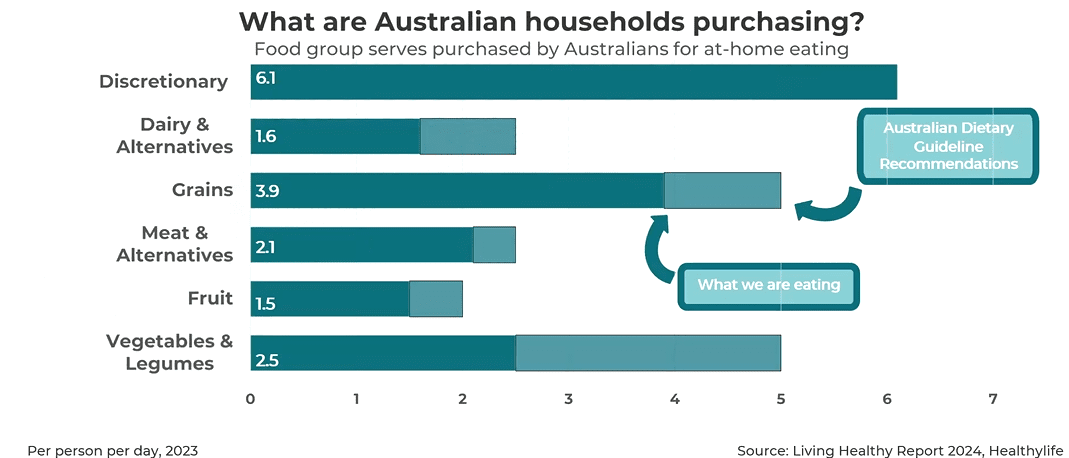
Kathy La Macchia addresses the GIWA forum held 9 October 2024. Photo: GIWA
AS GLOBAL diets rejig to factor in convenience, affordability and health, pulses are on the menu.
Speaking at the Grain Industry Association of Western Australia forum held October 9, delegates heard from Grains and Legume Nutrition Council general manager Kathy La Macchia about trends in human diets incorporating pulses to varying degrees.
The Federal Government has funded a review of the 2013 Australian Dietary Guidelines, and Ms La Macchia said GLNC was looking to make sure the importance of grains and legumes was not overlooked.
GIWA delegates also heard from Essantis co-chief executive officer Andrew May, who said pet food was the biggest market for Essantis’ pulse-protein concentrates being manufactured in Victoria using dry fractionation.
Chickpeas popular
GLNC’s focus is on evidence-based nutrition research to promote grains, legumes, and plant-based foods as part of a healthy diet, and it also conducts category audits.
In October 2023, it collected 359 legume products in retail supermarkets, and found canned legumes accounted for 41 percent of the total, while dried legumes at 25pc were down 15pc year on year.
“Consumers are time poor,” Ms La Macchia said.
“They have half an hour to cook their evening meal; they do not have time to prepare dried legumes, so we’re starting to see a shift more towards canned legumes.”
Ms La Macchia said tinned chickpeas were “hugely on trend”, displaying the most significant growth in any of the surveyed legume categories.
“We throw them in curries; we make hommus; we add them into various different dishes.”
Despite Australia being a significant grower and exporter of kabuli chickpeas, the survey found only 41pc of canned chickpeas were made with Australian ingredients, and 37pc came from Italy.
Ms La Macchiea said the other most popular canned legumes, namely red kidney beans, four-bean mix salad, and baked beans made with navy beans, were generally imported.
“Interestingly enough, we don’t grow a lot of these ingredients.
“What we found in the audit that we did was only 37pc of products in the supermarket in the legume category were made with Australian ingredients.”
Ms La Macchia said opportunities existed for Australian pulses to supplant those used in canned products.
Pulses rising on snacks chart
As a nutritionist, Ms La Macchia said she would love to think people ate three meals a day, but the reality is that people tend to snack six to eight times a day.
“A new category that just seems to have appeared overnight is called plant-based snacks.”
“Plant-based has not been left behind; 650 products have appeared in almost a blink on to our supermarket shelves.
“We have bliss balls; we have bars; we have crackers; we have chips.”
Ms La Macchia said plant-based snacks were spilling from the health-food section into other aisles, and 19pc were made using chickpeas.
“About 50pc of the bars and bliss balls are with faba, and we’re seeing a huge variety of different legumes that are being used in this category.”
She said start-ups rather than established food companies were making plant-based snackfoods.
“They’re on to trends, and we know chickpeas are on trend, fabas are on trend, and we’re seeing them start using these ingredients versus…soy that we’re seeing in the traditional food category.”
Discretionary items proliferate
Ms La Macchia also shared insights from a Living Healthy Report 2024 as commissioned by Woolworths, which showed purchases in every recommended food group were below the target.
In contrast, discretionary items were the most prevalent food item purchased, but were not ratified as part of a healthy diet.
“That’s all our chips, biscuits, pastries; these are foods that we don’t actually need, but we’re overeating in this particular category.
“If we actually look at what we’re filling our supermarket trolley with, it’s with discretionary foods.”
It also challenges the myth held by some that healthy eating is expensive.
“We can see that at cost per serve, the cheapest food category is still grain.”

Figure 1: Food group serves purchased by Australians for at-home eating. Source: Living Healthy Report 2024, Healthylife
Ms La Macchia said the results of the Woolworths survey show groups like the GLNC have their work cut out for them in boosting demand for healthy foods over discretionary items.
Fan of lupins
With WA one of the world’s biggest producers and exporters of lupins, Ms La Macchia was not backward in coming forward about her love of lupins.
“I love lupins; I love their protein level; I love what they do to the environment and I would love us to get them more into our food supply.”
However, they are grossly underrepresented in GNLC audits, and since 2021 across Australia, have featured in only 16 products.
“I really do think that there is a big opportunity there.”
Don’t forget the pets
Also speaking at the GIWA event was Essantis co-CEO Andrew May, who said a pleasant surprise for the business has been demand from the pet-food segment for its pulse protein.
“It is not particularly sexy, but there is a huge demand and usage in Australia in high-end grain-free pet-food diets for locally produced, allergen-free, gluten-free, sustainably grown, non wheat and non barley,” Mr May said.
“That is just an example of a market that’s not really getting talked about.”
Likewise, locally produced proteins made from pulses Australia has a natural advantage in growing, such as faba beans, could make inroads into aquaculture, already a significant industry in Australia.
“The aquaculture industry imports massive amounts of soy protein, massive amounts.
“Again, there is a view over time if we can build scale and get to a price point that can work, that is another market that convert to locally produced products.”
Mr May said gluten-free pasta, snacks, and bakery items, and protein-fortified noodles also offered opportunities for pulse protein.
“It’s a much bigger market than just sort of what is typically described as the alternate meat market.”

GIWA forum panel chair Tress Walmsley, GLNC’s Kathy La Macchia and Essantis co-CEO Andrew May in discussion at the GIWA forum held in Perth on October 9. Photo: GIWA
Changing trends
In her presentation, Ms La Macchia cited the projection that the global population is tipped to grow 2 billion by 2050 to 9.8B, including a doubling of the proportion aged over 60, and half the world’s population is expected to be overweight by 2035.
In Australia, 66pc of the population is overweight or obese, contributing to heart disease, diabetes and hypertension.
“Chronic disease is on the increase everywhere around the world.”
“This is going to have a huge impact on our economy and our health systems moving forward.”
This is despite low-salt, low-fat, low-cholesterol, and low-carbohydrate dietary trends seen since the 1980s and 1990s that have at times demonised everything from eggs to avocados to carbohydrates.
“Australians are still afraid of carbs.”
Ms La Macchia said high-protein diets have been on trend since the 1990s, as has the Mediterranean diet, which calls for increased consumption of olive oil, fruit, vegetables, and legumes.
“Since then we have progressed to what we now are living under, which is sustainable nutrition, so we’ve moved from looking at diseases and how we manage diseases in our diet to how we manage specific nutrients that could benefit us.”
Ms La Macchia said food was now looked at based on how it was grown, and what that meant for the next generation, as well as for its nutritional value.
“With this, we’re going to need double the amount of protein than we do today, and it cannot come from all the traditional sources of where we get protein today.”
Ms La Macchia said governments and activists around the world were saying plant protein was needed to supplement animal protein for the growing population.
Based on food trends, which Ms La Macchia said generally start in Scandinavian countries before expanding into central Europe and then other parts of the world, meat consumption is dropping.
“In all these guidelines, we’re actively encouraged to eat less meat; no-one is saying not to eat meat.
“What we’re encouraged to do is…eat more grains (and) legumes.”
“As part of our diet moving forward as our protein sources, this is really important for us in Australia because we are currently in the review stage of our Australian dietary guidelines which will influence how we will eat.”
Food Frontiers 2024 data indicates 25pc of Australians are actively reducing their meat intake, but 51pc of maintaining it, and “flexitarian”, with a mix of meat and non-meat meals, have the most popular diet.
“We’re a meat-loving country; there’s nothing wrong with that.”
Ms La Macchia said the cost of meat, as well as considerations about the environment and animal welfare, were expected to shift some people towards plant-based diets.
“I think it is really clear that cost of living is having an impact on all of us,” she said, citing Foodbank’s 2023 Hunger Report which stated 3.7 million Australians experienced food insecurity.
Grain Central: Get our free news straight to your inbox – Click here

HAVE YOUR SAY